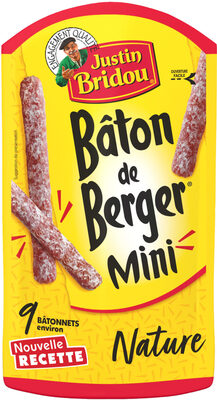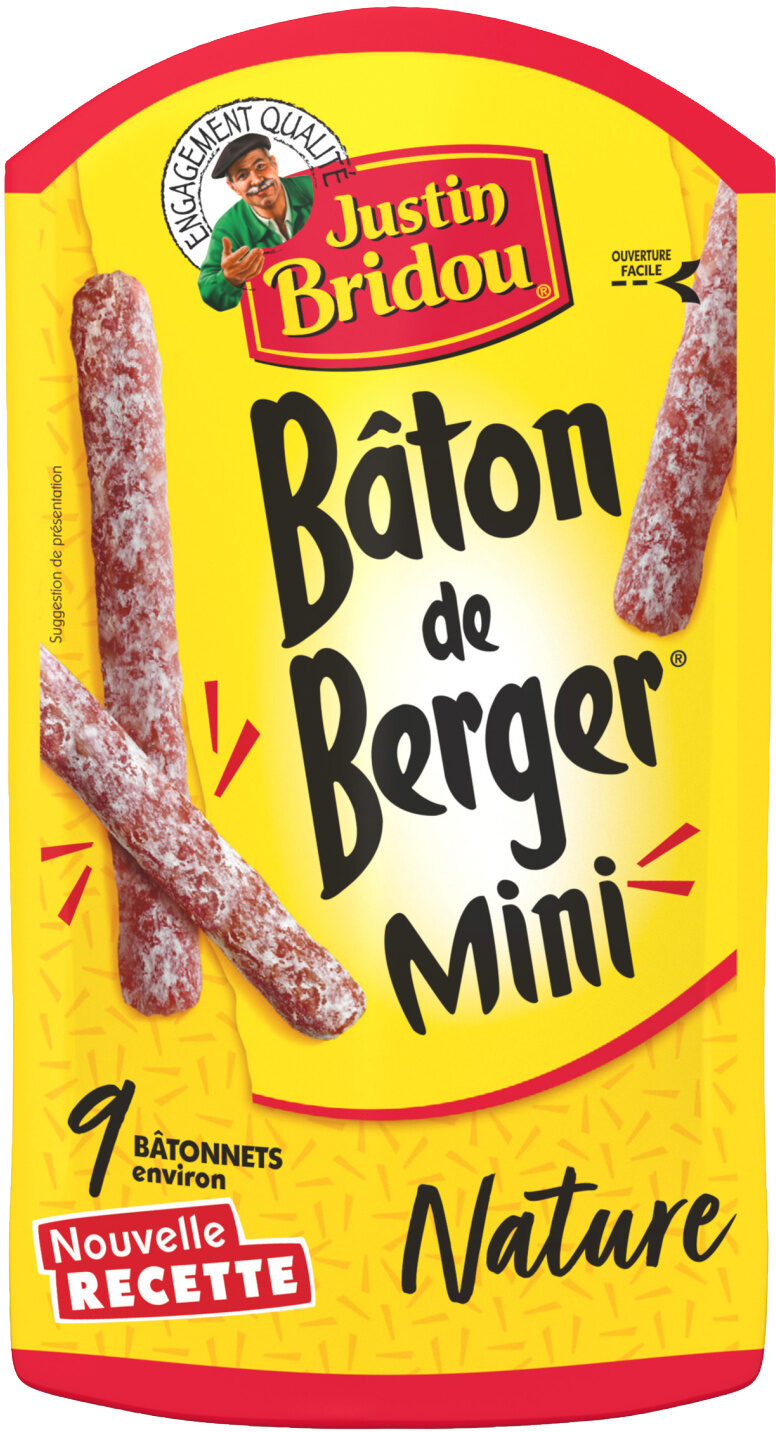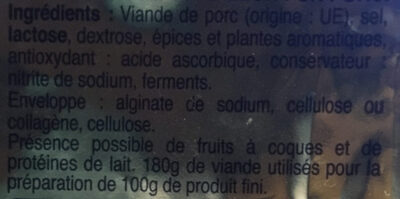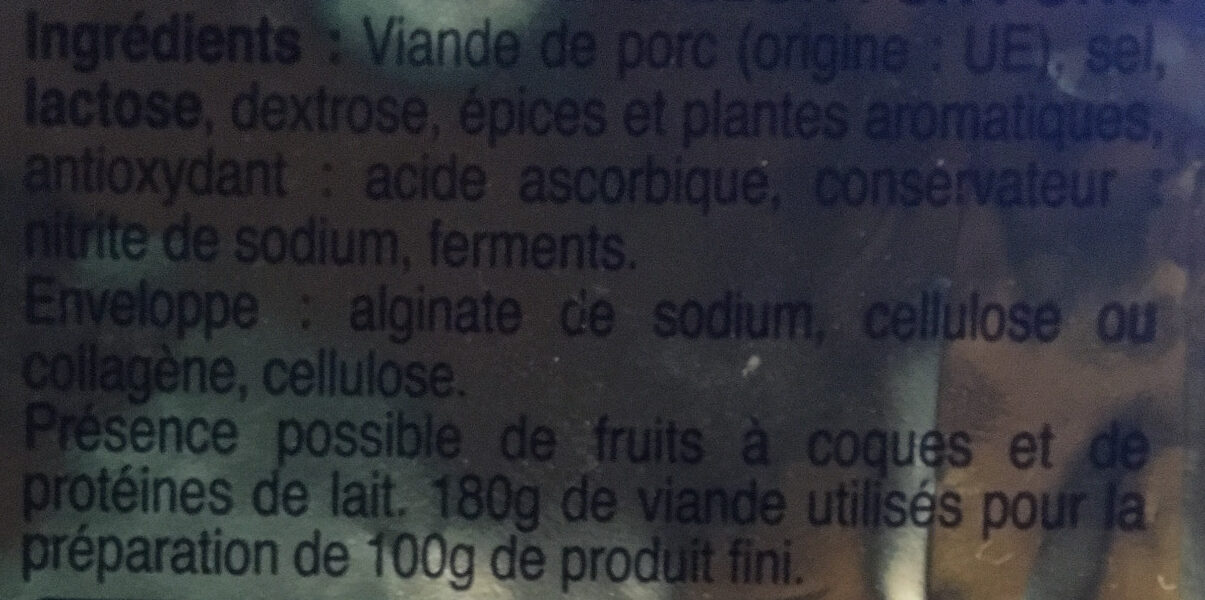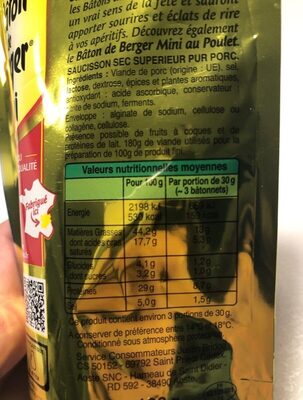Bâton de Berger Mini nature - Justin Bridou - 100g
Some of the data for this product has been provided directly by the manufacturer Aoste.
Barcode: 3449865240898 (EAN / EAN-13)
Common name: Saucisson sec supérieur pur porc
Quantity: 100g
Packaging: Protective gas, fr:Film en plastique, fr:Film plastique à jeter
Brands: Justin Bridou
Categories: Meats and their products, Meats, Prepared meats, Cured sausages, Dry sausages, Dry sausage pure pork, fr:Saucisses sèches, fr:Mini-saucissons-secs
Labels, certifications, awards: Made in France, New recipe, Pure pork, fr:Info-tri-point-vert
Origin of ingredients: fr:Poric Origine UE
Manufacturing or processing places: Aoste SNC - A SNC (Filiale Campofrio Food Group) - ZI Les Jacquards - 42520 Maclas, Loire, Rhône-Alpes, France
Traceability code: FR 42.129.001 CE - Maclas (Loire, France), EMB 42129 - Maclas (Loire, France), EMB 42129B - Maclas (Loire, France)
Link to the product page on the official site of the producer: https://www.justinbridou.fr
Stores: Magasins U, Intermarché, carrefour.fr
Countries where sold: France
Matching with your preferences
Other information
Conservation conditions: A conserver de préférence entre +14°C et +18°C.
Customer service: Service Consommateurs Justin Bridou, CS 50152 - 69792 Saint Priest Cedex
Report a problem
Data sources
The manufacturer Aoste uses CodeOnline Food to automatically transmit data and photos for its products.
Manufacturers can use the Open Food Facts free plaform for producers to access and complete this data, and to obtain reports, analysis and product improvements opportunities (e.g. better Nutri-Score).
Product added on by openfoodfacts-contributors
Last edit of product page on by jusdekiwi.
Product page also edited by date-limite-app, driveoff, elttor, foodvisor, fouji47, g123k, guepardow, inf, jacob80, kiliweb, magasins-u, org-aoste, packbot, ptivdt4wasm5muhy, quechoisir, roboto-app, sebleouf, tacite, teolemon, umar3x, yuka.RnBFNUUvOHN1OGdFbmNNUzlRMzVxdTVOKzhTVUJWeXpCckF6SUE9PQ, yuka.RzVJWk43a0hpS0F1eXZFdjRCejAxL2h1eFpHeFgxcTlKZFVSSVE9PQ, yuka.RzcwUk41d3dtdjFSc2ZJTy95N1dxL1VyM3NIMkJubTZHOEVJSVE9PQ, yuka.U0tkWVR2NFJtOFVLb05ndzh6ejA4ZUJudzUyd2MyMlpMZmN6SUE9PQ, yuka.UjcwTkhhbzZsdVpSc3ZKazNEWDg0ZnRKNXNId1RVRG9PdTR2SVE9PQ, yuka.VEpJcEQvNWZoOGdYaWM4c3pBM3E2dEZXN0xtU1JtSHNNczQvSUE9PQ, yuka.VjR3QkRwZ0QvZEF1Zzg5bitScUtvL1ZFeE1IMlpsbnNPOVlkSVE9PQ, yuka.WGIwdUdvQUQvTjBEeGNZTy9qVFA2dGRXOXFLWmJEdm1PckU3SVE9PQ, yuka.WHJnQVNma01nTWNtbzlvNS8weld5dW9xNTZiMlUzTHNGdE04SVE9PQ, yuka.WjQ0WU8vOEh1T0Fta2NNSHdrcnQ4WXhUKzdLRlhuT3pPK29wSVE9PQ, yuka.WklVdVRJOCsrc2trc2MxdTdESGN5dXh6Mm8zeVRVYTlJY05NSUE9PQ, yuka.ZDRFOE1hb0dpTndybk14ZzF6L1QyT0oyK1pHNWJHYW9PcnNiSVE9PQ, yuka.ZG9veFRJdGR0L280eE1GazJ4bkYvdmR3MXFEMWVUTzFHODh3SUE9PQ, yuka.ZHZrcEYvdzVpT3NyeXZkaG95UFg4ZFJiOWM2RFlEanVOdkpNSVE9PQ, yuka.ZjdFaEl2bzd0c1FJZ2ZkbndTL1MzZWx6MzZLMkEwU2xKY1lXSWc9PQ, yuka.sY2b0xO6T85zoF3NwEKvlhcWCIT4iBv9BSbmoFCb6IuiKsHaO_5Zzor8Mas.
